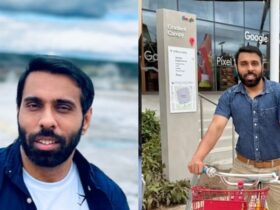Foreword: While the character Emilia is imaginary, this vision of life in Berlin in 2050 is shaped by current scientific insight and modeling projects for urban development.
Emilia wakes up for a great dazzle, jumping from its neighbor’s solar panels. She only moved to a neighborhood trapto in the southeast of Berlin last week and still needs curtains. She makes a mental note to check the nearest secondhand shop.
She gets up and slips into a shirt that she picked up a cloth exchange and a skirt that she inherited from her mother. It is worn slightly in places, but it is just an opportunity to patch and make it.
Like most people, she knows, she enjoys making her styles.
It is difficult for him that her mother sometimes imagines the days of fast-fashion, when people may be before leaving them to buy clothes. Or never at all. A lot of it was finished, which was dumped in the oceans.
Emilia shook her head, thinking that, puts a selfie to send her girlfriend Sophia, which has already left for work. He is a solar panel installer, a profession that is in high demand.
Once he completes his studies in sustainable fashion, Emilia likes to find the work easy.
Green Space, Trains and City River Swimming
It is hot out, but the July heat is not as bad as whey, which often lives indoors inside the access of cooling system-moley window heat pumps for old apartment buildings and low-energy designs and insulation in new blocks.
Emilia often arises at sunrise for a quick dip in the Hod River. For a lot of disappointment of his parents. They still recall how it was when they were children, before the prevention of broad sewage, filtration and UV treatment applied water quality.
This is not the only difference of opinion on the use of water. Waiting for her train, Emilia recalls how much conversation she had to persuade her parents to start the harvesting of rain – more than as she can count. But during the recent draft, his father proudly announced how everyone in his block on the other side of the city was storing rain water to wash their clothes, flushed his toilet and watering the plant.
Residents feel a shared feeling of responsibility to take care of plants, understanding how important they are in helping the city to keep cool and reduce the CO2 emissions.
Emilia’s parents are in their early 50s and most generations agree that there is now a better place to live in the city, despite storms, falls and heatwaves that have risen with rising temperatures. There is a feeling of being the owner of progress that he has helped everyone to create.
Emila gets a seat on underground, which is busy but Spath does not get crowded. Berlin’s transport system has twenty skilled over the years, with a mixture of acuters, trams, subway, trains and bikes. People had to pay to stand in warm, tight trains once, but nowadays, they can be around for free in temperature controlled cars. Or bike with designated tree line lane.
The underground originates from a tunnel and the Emilia looks out of the window for a long time of greenery from the window that used to be roads. In the last decades, one -third of the city’s roads have united the bees to help the raw arthraj ground water when it rains. It is difficult to imagine that one million cars are driving where there are now parks and community gardens.
Increasing mangoes in city offices
Equipped with the doors that automatically close the reflective walls, shutters and good insulation, the university, like many public buildings, is cool. Even the canteen where Emilia tucks in its 3D-printed stake and vegies remaining Eat He cooked his parents last night.
Like most people, her mother switched to a large-scale plant-based diet long ago, but her father has become difficult to change. He still eats meat or fish once a week, but has come around the idea of making Sura Local level sour.
Last night, he made his high-technical stake made of animal cells grown in the laboratory, even without realizing that it was not from a real cow. And for the entertainment of Emilia, he could not distinguish. Nor did he It is not that she lasts for the last time that she ate a traditional stake.
She immerses it in the sauce she made from mangoes that are now grown in Berlin. It is strange to think about a piece of fruit traveling in half the way worldwide. Especial Beat Emilia never remained in an aircraft herself. And she cannot imagine that she is never in a world where she can travel 1,500 km (930 mi) by high-speed train from Berlin to Helsinki in five hours.
When his father was of his age, that journey took a full day by road or train with a lot of stops on the way. Hence the aircraft were a popular option. Nowadays, if people fly, it occurs on aircraft powered by green fuel or electricity, and roughly only when they leave the continent.
But back in mangoes. They are grown in containers in old offices converted for food production. In the last two decades, urban agriculture has blossomed with roof fields, vertical systems and community greenhouses across the city.
Investing in food they grow has made people less waste, as there are zero-prostitute movements and suggestions to use things like bread, old fruits and incomplete vegetables. And any garbage animals are fed large.
Innovative
When Emilia returns from the university late afternoon, its flat is the right temperature. Its smart home system is programmed to cool the space in summer and heat in winter with geotomal heat pumps for the entire building. The city’s energy system works efficiently. What is more, extended rollouts of Berlin’s solar panels and wind parks and regional energy sharing means that it now runs on 100% renewable items.
She remembers how she was not needed when she was not needed, how would there be any kind of light. But now people have become more aware about energy consumption and resource use. She takes a water -saving shower, remembering how she used to bathe instead.
Even her grandmother has been taken out of her bathroom and now keeps her in her garden to collect rain water. The need is a motor to change, he said at that time.
Shown and dressed, she reads a message from a flop and Sophia on the second hand sofa, stopping to drink some beer from recycled bread. Emilia sends a heart. Not just because his partner is coming back to his shared home with his favorite drink, but because he understands that the city cannot easily become which is today.
She heard enough to know that when she was born 25 years ago, there was something about the immediate need to take action on climate change. She expresses gratitude to activists, policy advocates, journalists and entrepreneurs who refused to insist for change.
He has often thought how difficult it would have been to swim against the tide, but so it was how satisfactory it was when governments started supporting the initiative and disintegrating the economy. And how much exciting bees should be seen back and then to see the mindset and then the city shifted to become something new.
And not only Berlin, in fact, but the whole world. As the country used with local solutions and got inspiration from each other, community action spread, gradually translation for a collective and dramatic global change.
Emilia looks out of the window Where the sun is slowly drowning on the day, feeding its rays in solar panels and he smiles as to what lakes he lakes.
Afterward: This is just a possible version of 2050 if the world works to slow climate change.
Edited by: Tamsin Walker, Jennifer Collins, Anke Raiper






Leave a Reply